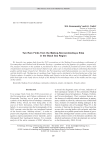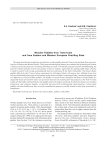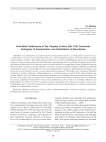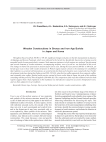The metal ages and medieval period. Рубрика в журнале - Archaeology, Ethnology & Anthropology of Eurasia

Turning points in horse breeding in the Eurasian steppes and the Near East
Статья обзорная
Бесплатно

Two rare finds from the Maikop-Novosvobodnaya sites in the Black Sea region
Статья обзорная
Бесплатно

Types of construction nails from Markul, Abkhazia (based on metallographic analysis)
Статья научная
During excavations at the Markul fortified settlement, Republic of Abkhazia, a cluster of iron items, including nails, was found. Nails usually draw little attention as they cannot serve as chronological indicators. Several attempts at constructing a typology of nails have proved unsuccessful. The quality of metal of which they were forged has not been studied purposefully, although it can be relevant to the use of nails and construction practices. Here, we present the results of a metallographic analysis of 19 nails from Markul (13 spec. from a simultaneously formed cluster of iron items, and six spec. found elsewhere at the site). The findings suggest that they can be subdivided into three types in terms of metal structure and, accordingly, of properties of nails: those with a ferrite structure ("soft"), those with a ferrite-pearlite structure ("strong"), and those with a cementite structure ("extra strong"). These types correlate with three types of construction materials used in Abkhazia in the Late Classic and Medieval period. Lack of correlation between metric properties of nails and metal structure suggests that the latter was intentionally formed for specific tasks, depending on the characteristics of the details joined by nails.
Бесплатно

Статья научная
In the 13th and 14th centuries, there was a custom of placing parts of a ram/sheep carcass in the grave as an offering in the Baikal region. Materials from three areas, which were then parts of the Mongol Empire, are described: southeastern Trans-Baikal, northern Khövsgöl, and southern Angara. Graves are described with a focus on sheep bones, their composition, and location in the grave. In the southern Trans-Baikal, the shank was usually placed near the buried person’s head. Scapulae and vertebrae are much less frequent than shank bones. The latter are most often found under the human pelvic bones or under the upper femur. In the Khövsgöl area, a ram’s shank was placed near the deceased person’s arm or leg. On the Angara, a ram’s head—or the entire dorsal part—was placed near the deceased’s legs. In the Sayantui type burials, located south of Lake Baikal and representing the Mongols’ funerary tradition of the imperial period, the most common offering was a ram’s shank, placed upright. Elsewhere in the Baikal region, other ways of arranging parts of a ram carcass are observed, apparently because of the absence of the Mongol population and its elite in those areas.
Бесплатно

Vengerovo-2-A Krotovo culture site in the Baraba forest-steppe: an archaeozoological study
Статья научная
This study addresses faunal remains from Vengerovo-2 in the Baraba forest-steppe—a Bronze Age site associated with the Krotovo culture. We describe the origin of the sample, the distribution of bones in the living space, the species and skeletal parts represented, and the age of the animals. The sample consists of small fragments, which are likely butchering and kitchen waste, as well as the leftovers of production and rituals. Bones of domesticated animals are more frequent (62 %) than those of wild ones. Skeletal parts from utility pits (pelvic bones, ribs, and appendicular bones) differ from those found in production areas—mandibles, crania, and entire skeletons. Presumably, pits contained food, and production areas were places where work was accompanied by rituals. The reconstructed animal breeding system indicates its domestic nature, centered on sheep and goats, with a small number of horses and cattle. Hunting large prey (elk and roe deer) was important, and the same is true about fur animals (fox and marten) and waterfowl. The procurement of peltry, hides, and leather were principal occupations. Bone tools were made mostly from elk bones. Results of correlation analysis suggest that in terms of composition, the faunal sample was largely similar to those from contemporaneous Krotovo and Yelunino sites.
Бесплатно

Статья
This article presents 44 radiocarbon dates from 18 water wells of different Bronze Age periods at Kamennyi Ambar settlement, in the southern Trans-Urals. At the preliminary stage, statistical outliers were identifi ed, which enhanced the reliability of the conclusions. Potsherds from the fi lling of the wells, contextual analysis of dating samples, and 14C dates allowed us to carry out the cultural attribution of nearly all wells (31 out of 34). The analyzed wells were subdivided into four chronostratigraphic groups corresponding to various settlement phases. Their duration and chronological limits were estimated. Most wells were found to belong to the Sintashta-Petrovka period (densely spaced linearly arranged blocks of structures inside fortifi ed areas). This period comprised three construction phases, the latest of which correlates with the Petrovka ceramics. The second period, marked by randomly arranged structures, is associated with the Srubnaya-Alakul artifacts, and is represented by only four wells. The simulation results suggest that the site existed for less than one and a half centuries, including a short chronological gap between the two periods. The Sintashta (phases 1 and 2) and Petrovka (phase 3) were two consecutive traditions, which may have overlapped during the late period. In the Srubnaya-Alakul period (phase 4), a transformation of the architectural tradition took place, and the layout and construction of the wells changed too.
Бесплатно

Wooden Paddles from the Nizhny Tagil Museum-Reserve of Mining and Metallurgy in the Urals
Статья научная
This article describes Early Metal Age wooden paddles from the Gorbunovo peat bog, kept by the Nizhny Tagil Museum-Reserve of Mining and Metallurgy in the Urals. Their morphology and manufacturing technology are analyzed. The archaeological context and new AMS-dates are introduced. This sample of early wooden paddles is the largest and the most representative in the world. The specimens are very standardized with regard to general proportions, shape of the blade and handle, and decoration of the handle. A distinctive feature of this sample is that the handle of certain specimens is composite. A comprehensive traceological and technological analysis of the paddles has revealed several aspects of their manufacture, and xylotomy has provided information about the species of wood (pine, cedar, and spruce). On the basis of the processing traces, a tentative toolkit was reconstructed. The paddles generally fall in two categories: most are one-piece, and a few are composite. During the Early Metal Age, woodworking was probably a traditional craft in the Trans-Urals, showing a number of customary techniques.
Бесплатно

Wooden paddles from Trans-Urals and from eastern and Western European peat-bog sites
Статья
Бесплатно

Woven, knitted, and wattled 17th–18th century textiles from Tara fortress, Western Siberia
Статья обзорная
Бесплатно

“Caster's cache” from Tartas-1, late Krotovo (Cherno-ozerye) culture, Baraba forest-steppe
Статья обзорная
Бесплатно

Статья научная
We describe two metal vessels, procured by looters and offered to D.G. Messerschmidt, who in 1722 traveled across southern Krasnoyarsk Territory. A bronze cup, judging by a description in researcher's journal and by the accompanying drawing, resembled Old Turkic specimens. However, the hunting scene engraved on its body suggests Chinese provenance. A silver vessel from the vestry of Fort Karaulny church is peculiar to 7th–10th century Sogdian toreutics. It evidently belongs to a group of vessels with polygonal bodies, specifi cally to type 1—octagonal. Having been manufactured in Sogd, polygonal vessels were exported to China. Chinese jewelers copied the form of “wine cups” and adorned them with traditional fl oral designs and various scenes. An octagonal silver cup with an Uyghur inscription, found in 1964 in a kurgan at a medieval cemetery Nad Polyanoi, was likewise manufactured by Tang artisans. Other polygonal silver cups are listed—heptagonal and sexagonal. It is concluded that vessels made of precious metals testify to stable trade relations that emerged in 700–1100 and connected Siberia with Sogd and the Tang Empire.
Бесплатно







